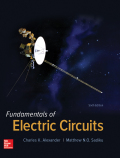
A series RLC network has R = 2 kΩ, L = 40 mH, and C = 1 μF. Calculate the impedance at resonance and at one-fourth, one-half, twice, and four times the resonant frequency.
Find the value of the impedance at resonance and at one-fourth, one-half, twice and four times the resonant frequency.
Answer to Problem 25P
The value of the impedance at resonance
Explanation of Solution
Given data:
The value of the resistor
The value of the inductor
The value of the capacitor
Formula used:
Write the expression to calculate the resonant frequency.
Here,
Write the expression to calculate the impedance at resonance of series RLC circuit.
Here,
Write the expression to calculate the impedance of the series RLC circuit.
Calculation:
Substitute
Simplify the above equation to find
(1) Impedance at resonance:
Substitute
(2) Impedance at one-fourth of the resonant frequency:
Here, the resonant frequency
Substitute
Substitute
Simplify the above equation to find
(3) Impedance at one-half of the resonant frequency:
Here, the resonant frequency
Substitute
Substitute
Simplify the above equation to find
(4) Impedance at twice of the resonant frequency:
Here, the resonant frequency
Substitute
Substitute
Simplify the above equation to find
(5) Impedance at four times of the resonant frequency:
Here, the resonant frequency
Substitute
Substitute
Simplify the above equation to find
Conclusion:
Thus, the value of the impedance at resonance
Want to see more full solutions like this?
Chapter 14 Solutions
EBK FUNDAMENTALS OF ELECTRIC CIRCUITS
- Can you help me find the result of an integral 0/2 a² X + a dxarrow_forwardQ1/Sketch the root locus for the system shown in Figure 1 and find the following: a. The exact point and gain where the locus crosses the jo-axis b. The breakaway point on the real axis c. The range of K within which the system is stable d. Angles of departure and arrival R(s) + K(s²-4s +20) C(s) (s+2)(s + 4)arrow_forwardExam2 Subject: (Numerical Analysis) Class: Third Date: 27/4/2025 Time: 60 minutes Q1. For what values of k does this system of equations has no solution? (use Gauss-Jordan eliminations) kx + y + z = 1 x+ky + z = 1 x+y+kz=1arrow_forward
- Consider the Difference equation of a causal Linear time-invariant (LTI) system given by: (y(n) - 1.5y(n - 1) + 0.5y(n = 2) = x(n) a) Implement the difference equation model of this system. b) Find the system transfer function H(z). c) For an input x(n) = 8(n), determine the output response y(n). d) Verify the initial value theorem y(0) with part (c).arrow_forwardQ5B. Find the type of the controller in the following figures and use real values to find the transfer function of three of them[ Hint Pi,Pd and Lead,lag are found so put the controller with its corresponding compensator]. R₁ R₂ Rz HE C2 RA HE R₁ R2 RA とarrow_forwardQ1// Sketch the root locus for the unity feedback system. Where G(s)=)= K S3+252 +25 and find the following a. Sketch the asymptotes b. The exact point and gain where the locus crosses the jo-axis c. The breakaway point on the real axis d. The range of K within which the system is stable e. Angles of departure and arrival.arrow_forward
- Determine X(w) for the given function shown in Figure (1) by applying the differentiation property of the Fourier Transform. Figure (1) -1 x(t)arrow_forwardCan you solve a question with a drawing Determine X(w) for the given function shown in Figure (1) by applying the differentiation property of the Fourier Transform. Figure (1) -1 x(t)arrow_forwardAn inductor has a current flow of 3 A when connected to a 240 V, 60 Hz power line. The inductor has a wire resistance of 15 Find the Q of the inductorarrow_forward
- صورة من s94850121arrow_forwardThe joint density function of two continuous random variables X and Yis: p(x, y) = {Keós (x + y) Find (i) the constant K 0 2 0arrow_forwardShow all the steps please, Solve for the current through R2 if E2 is replaced by a current source of 10mA using superposition theorem. R5=470Ω R2=1000Ω R6=820Ωarrow_forwardarrow_back_iosSEE MORE QUESTIONSarrow_forward_ios
 Delmar's Standard Textbook Of ElectricityElectrical EngineeringISBN:9781337900348Author:Stephen L. HermanPublisher:Cengage Learning
Delmar's Standard Textbook Of ElectricityElectrical EngineeringISBN:9781337900348Author:Stephen L. HermanPublisher:Cengage Learning
